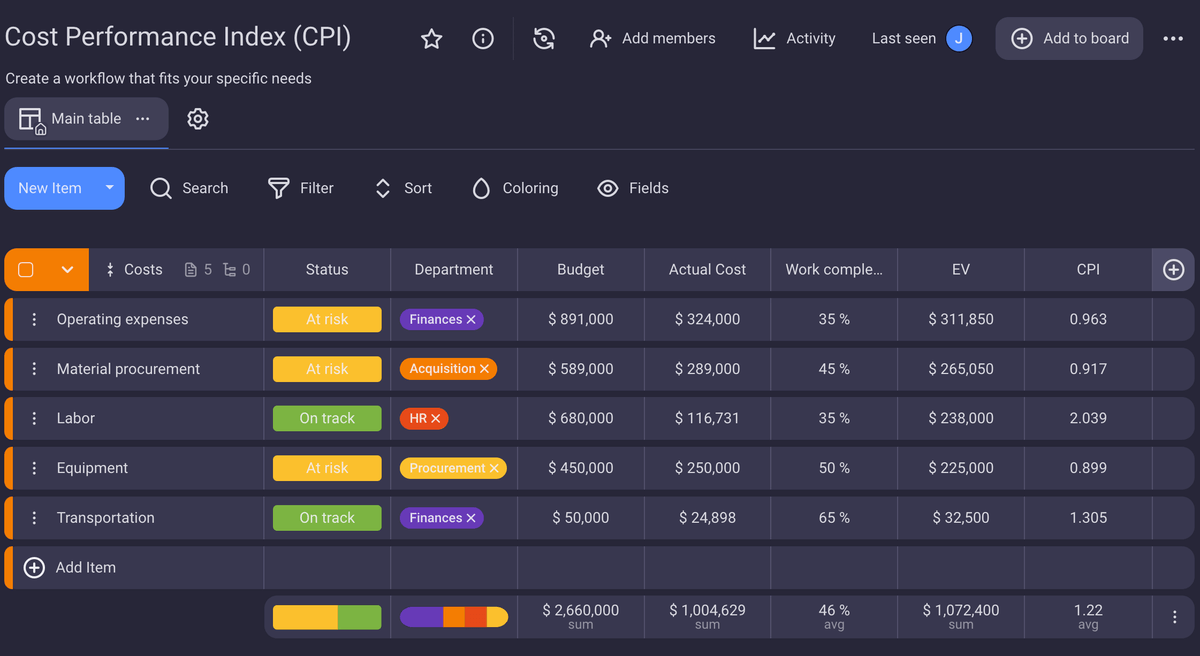Monitoring costs is an essential part of project management and is performed for each project, no matter how small.
The cost performance index (CPI) is one of the methods used to calculate how cost-effective a project is and whether the budget plan is on track.
Learn all about the formula to calculate your project’s CPI and find out through examples what different results can tell you about current project performance.

- The cost performance index (CPI) monitors the project’s budget by comparing the planned and actual costs.
- The formula for CPI includes earned value (EV) and actual cost (AC).
- If the value of CPI is less than 1, the project is over budget.
- Calculating CPI throughout the project’s development lets project managers spot cost overrides on time.
What is the cost performance index (CPI)?
The cost performance index (CPI) measures the project’s financial performance and the cost efficiency of budgeted resources.
As a cost-efficiency measure, CPI shows how effectively the project sticks to its budget.
The cost performance index helps us identify if our project expenses are as planned or whether we are performing over or under budget.

CPI is just one of the many metrics used in earned value management (EVM). To learn more about other important project indicators, read this guide:
Free project management software
Streamline your business — improve planning, align teams, finish tasks with Plaky.

How to calculate CPI
The formula to calculate the cost performance index is:
CPI = EV / AC
CPI in project management is the ratio between earned value (EV) and actual cost (AC).
The earned value metric represents the completed work and is also called the budgeted cost of work performed (BCWP). You can calculate it using the following formula:
EV = % work completed x total budget
The actual cost metric shows how much money you have spent on project work to a certain point in time.
The value of CPI tells you whether the project is under or overperforming financially:
- CPI > 1 — The project is under budget.
- CPI = 1 — The project is on budget.
- CPI < 1 — The project is over budget.
For example, a CPI of 0.5 indicates you have spent twice the sum you should have at the time of the calculation.
Conversely, a CPI of 2 means you have spent only half the sum you should have at this point.

CPI is similar to cost variance (CV), as they both calculate the difference between the expected and actual project costs. To learn more about CV through examples, read this guide:
Keep an eye on project costs with Plaky
CPI vs. EAC
While CPI is a useful enough metric in its own right, it’s also used as a variable for calculating other metrics. For example, we can use CPI to calculate the estimate at completion (EAC) for our project.
This formula is used to calculate EAC when the project is performing as planned:
EAC = BAC / CPI
EAC is the forecast of the project budget at its completion calculated while the project is still in progress.
When the CPI value indicates that we are overspending, calculating the EAC should reveal the total amount of money we’ll spend on our project.
Cost performance index (CPI) examples
Whether you are managing a small project team, leading a game development project, or planning a nonprofit event, you should always track cost efficiency.
We’ll go through examples of the following scenarios:
- CPI is less than 1,
- CPI equals 1, and
- CPI is over 1.
Example #1: CPI is less than 1
Suppose your team is working on a product launch.
The project budget is $100,000, and 50% of the planned work has been completed.
Your team has already spent $70,000 on project activities, and you want to check whether the costs align with the initial plan.
First, you need to determine the earned value:
EV = % work completed x budget
EV = 50% x $100,000 = $50,000
Then, to calculate the cost performance index, divide the earned value by the actual cost.
CPI = EV / AC
CPI = $50,000 / $70,000
CPI = 0.71
The CPI value is 0.71, which means your project team is overspending.
Example #2: CPI of 1
Now, let’s say that you’re leading a project team that’s making a new video game.
The project budget is $150,000, and 50% of the planned work has already been completed.
Your project team has already spent $75,000 on project activities (actual costs). To calculate the earned value, you can use this formula:
EV = % work completed x budget
EV = 50% x $150,000 = $75,000
The cost performance index is the ratio of earned value to actual cost:
CPI = EV / AC
CPI = $75,000 / $75,000
CPI = 1
The CPI value of 1 means project costs are as planned.
Example #3: CPI is over 1
Finally, imagine your company is in charge of corporate event planning for one of your clients.
The project budget is $150,000, and the project team has done 40% of the planned work, spending $45,000 on project activities so far.
To determine the CPI, we first need to calculate the earned value and the actual cost.
EV = % work completed x budget
EV = 40% x $150,000 = $60,000
We already know that the actual cost is $45,000, which is how much the project team has spent. So, we can now apply the CPI formula:
CPI = EV / AC
CPI = $60,000 / $45,000
CPI = 1.3
As you can see, the CPI is greater than 1 — meaning we are doing better than expected budget-wise.

For more on project accounting in general, including ways in which it’s different from regular business accounting, read this guide:
Free project management software
Streamline your business — improve planning, align teams, finish tasks with Plaky.

The benefits of calculating CPI
The benefits of the cost performance analysis are significant for:
- Budget monitoring — Calculating CPI and other important project KPIs regularly helps project managers monitor budget spending and check whether everything is developing as planned.
- Cost control — Keeping track of the project’s cost-effectiveness means ensuring all expenses are under control and no activity costs more than necessary.
- Improved resource management — Continuously observing costs lets project managers learn which resources are the most expensive and find ways to reduce costs.
- Timely action — Checking whether the project is on budget during its development gives you the opportunity to take corrective action on time and prevent project failure.
- Better stakeholder management — Keeping stakeholders in the loop is much easier when you perform regular checks and can inform them when additional funds are needed before the project goes into the red.

Monitor cost performance with Plaky
Specialized project management software like Plaky provides a simple and intuitive way to keep your projects on track and monitor important project KPIs.
After all, having a project checklist and all budget-related information in one place is a much more user-friendly alternative to any spreadsheet.
Free project management software
Take control of your team's workload and achieve better project results with Plaky.

With Plaky, you can:
- Manage your projects on individual boards, allowing each subteam to streamline its workflow,
- Choose the board view that best fits your processes so that you can spot bottlenecks right away,
- Keep a close eye on all key project parameters with custom fields (and manage potential cost overruns on time),
- Save precious time by automating calculations with the summary row, and
- Avoid delays and misunderstandings by notifying the right people in real time about important project updates.

To find out more about everything that Plaky offers, check out the following page:
When you’re all set, your cost performance index board may look like this:

As you can see, you can manage your projects in Plaky and let it calculate CPI for you. Create custom fields for each item and enter the actual cost as well as the planned budget. Then — without even using a calculator — monitor the results in the summary rows.
So, what are you waiting for? Try Plaky today and unlock all premium features with a 14-day trial.
